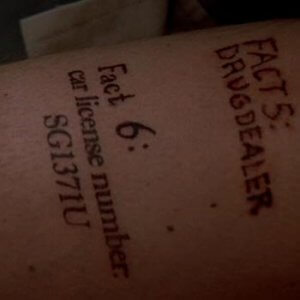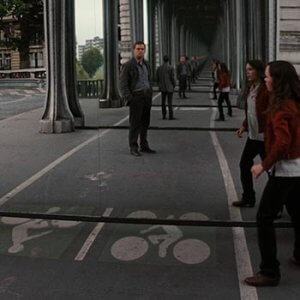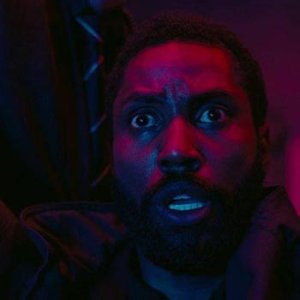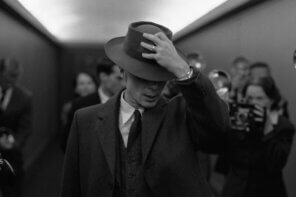If you take Christopher Nolan’s work as a whole, it’s possible to discern the emergence of a common concept — what we might call a narrative MacGuffin unifying all his movies: How does memory loss affect perception of reality? How do dreams affect perception of reality? How do magic tricks affect perception of reality? How does insomnia affect perception of reality? How does time inversion affect perception of reality?
Nolan has established himself as a director adept at exploring the relationship between time, memory, and reality — as well as how these concepts can be perceived, rearranged, and distorted. But even if his feature-length oeuvre is fairly cohesive, it can still be divided into three separate acts, each of which has lasted an average of ten years (to date). We will label these three Acts:
- “Before his time”
- “It’s about time”
- “Time, times, and half a time”
Fair warning: a proper evaluation of this subject necessitates detailed and lengthy analysis. So grab your favorite beverage, take a seat, and put on some slippers: we have a lot of ground to cover.
Act 1: “Before His Time” (1989 – 1999)
The first act of Christopher Nolan’s career as a filmmaker is marked by obscurity, experimentation, and repeated failures. As he struggled to get a footing in the filmmaking industry, he acquired quite a collection of rejection letters.

During this period, Nolan worked on a small number of independent and/or unreleased films, including several shorts. An early feature-length effort, entitled Larry Mahoney, evidently made it all the way into the post-production phase. However, upon review of a rough cut of the film, the project was abandoned due to story problems that couldn’t be resolved.
Finally, in 1998, Nolan successfully completed a feature-length project. Entitled Following, and shot in black and white on a budget of approximately $6,000, the movie details the antics of an aspiring and out-of-luck writer with a proclivity for following complete strangers. He allows his people-watching habits to morph into acts that further push the boundaries of social acceptability: stalking, petty theft, burglary, and more. The story jumps back and forth in time, the reason for which is explained by Christopher Nolan himself:
“In a compelling story of this genre [i.e., noir] we are continually being asked to rethink our assessment of the relationship between the various characters, and I decided to structure my story in such a way as to emphasize the audience’s incomplete understanding of each new scene as it is first presented.”
Following acts as a transitional piece between Nolan’s first and second phases, in that it foreshadows each of the director’s films in Act 2: black-and-white photography mixed with a non-linear storyline (Memento); a protagonist who slowly compromises his relationship with the law (Insomnia); two colleagues who become more and more at odds with each other, as revealed through three separate timelines (The Prestige); a main character named Cobb who is a thief (Inception); and a repeated and prominent display of the Batman logo (the Dark Knight trilogy).
Following put Christopher Nolan on Hollywood’s radar, ending his first Act as a director and ushering in Act 2.
Act 2: “It’s About Time” (2000 – 2014)
As a caveat to my title for this second Act: not all the films in this epoch are literally about time. Rather, the films in Act 2 represent Nolan’s emergence and solidification in Hollywood as a top-tier director.
The shift from Act 1 to Act 2 isn’t marked so much by a tonal shift in Nolan’s work as it is a tonal development, as well as a notable increase in production values, star power, and global prominence. The thematic hallmarks that garnered Nolan attention during Act 1 (particularly bending and warping our perception of reality) are carried into Act 2 — and, as we shall see, Act 3 as well.
A staple of this phase is Nolan’s special interest in anti-heroes with questionable motives and/or methods. As such, the protagonists in the films of this era are not Hitchcockian bystanders dragged into a world of danger and deception. Rather, danger and deception function as their wheelhouse, either by force or choice (or a mixture of both).
Looking at Nolan’s output during this phase, a few characteristic themes emerge. First, with the exception of The Prestige, all these stories involve the world of crime — with the protagonists often ending up on the wrong side of the law. (In The Prestige, the magicians don’t commit crimes, per se, but their willing intent to violate the safety and lives of others at the very least borders on criminal.)
Second, the main characters in these films readily employ deception to accomplish their goals. Sometimes these goals are noble; often, they are not. Nolan’s characters tend to fabricate aspects of their reality to either fool themselves or others, as well as to manipulate those around them toward their specific and desired ends. In some of these cases, reality — or the perception of reality — is stretched to the breaking point.

Third, and without exception (although to varying degrees), the protagonists in all these films require, either by force or necessity, the sacrifice of others in order for their plans to be fulfilled. Their achieved goals provide burdens for others to bear — either with lost opportunities or lost lives.
With these characteristic themes in mind, let us examine each of the films in Act 2.
Memento, Nolan’s first film featuring Hollywood stars, is a time-bending narrative in which memory — or, more specifically, the lack of memories — can effect one’s perception of his world. The story is told in reverse chronological order, from end to beginning, which brilliantly puts the viewer in the position of protagonist Leonard Shelby (who, with no short-term memories, cannot fully understanding what has just previously happened to him). At first, Shelby seems to be devoted to a sympathetic cause (if not using the noblest methods). But as the story progresses, the truth becomes more complicated, as we discover that much of the deception surrounding Shelby’s beliefs are — like the tattoos that cover his body — self-inflicted.
Nolan’s next project, Insomnia, is a remake of a 1997 Norwegian film, in which detective Will Dormer arrives on the scene of a small town to investigate the murder of a teenage girl. Dorner is a victim of insomnia, exacerbated by the Alaskan midnight sun, a phenomenon in regions north of the Arctic Circle where the sun never completely sets for a portion of the year. Just as it is nearly impossible to tell the difference between night and day, so it becomes harder and harder for Dormer to tell the difference between right and wrong. No stranger to moral compromises, Dormer slowly finds himself losing his grip on reality.
In The Prestige, Nolan once again employs a complex narrative structure, jumping back and forth between different timelines. Based on the lives of two magicians obsessed with their work (to the detriment of everyone they know and love), the film explores the process of these master craftsmen transforming from colleagues into rivals — and, ultimately, enemies. The tension continually escalates, as each magician resorts to more deception and one-upmanship. It’s hard to argue that there’s an actual “good” guy, although our sympathies are eventually swayed in one particular direction. Even so, both magicians have as many vices as the film has black hats.
 With Inception, we arguably see Nolan reaching the zenith of his career. This ingeniously original caper film treats reality like a labyrinth: a complex combination of inter-dependent dimensions. In the world of the dream, an individual can be manipulated by an architect (like protagonist Dominick Cobb) into revealing valuable and proprietary information, which can then be sold at the dreamer’s expense. While we can sympathize with Cobb’s end game (i.e., wanting to be reunited with his estranged children), his methods remain questionable — and all the more so as the plot thickens. By withholding vital pieces of information from his team members, Cobb convinces them to push the boundaries of the dream world, eventually threatening the minds, sanity, and lives of everyone involved.
With Inception, we arguably see Nolan reaching the zenith of his career. This ingeniously original caper film treats reality like a labyrinth: a complex combination of inter-dependent dimensions. In the world of the dream, an individual can be manipulated by an architect (like protagonist Dominick Cobb) into revealing valuable and proprietary information, which can then be sold at the dreamer’s expense. While we can sympathize with Cobb’s end game (i.e., wanting to be reunited with his estranged children), his methods remain questionable — and all the more so as the plot thickens. By withholding vital pieces of information from his team members, Cobb convinces them to push the boundaries of the dream world, eventually threatening the minds, sanity, and lives of everyone involved.
An evaluation of Act 2 would be incomplete without addressing Nolan’s Batman films. While his Dark Knight trilogy utilizes a fairly straight, linear narrative structure, he also plays around with the concept of reality — albeit, in something of a reverse direction. Whereas earlier iterations of Gotham’s anti-hero were set in alternate realities of one kind or another, Nolan attempts to root the caped crusader in the real world. In so doing, these films jettison the campiness of the Adam West TV series, the gothic cartoonishness of the Burton films, and the outlandishness of the Schumacher movies, establishing a new cinematic mythos around the character of Batman. Of course, all of the films’ villains challenge, in their own ways, the nature of reality as Bruce Wayne, and the citizens of Gotham, see it.
Although Batman’s motives are decidedly nobler than those of Nolan’s other protagonists (he genuinely wants peace and justice), he nevertheless bends the rules to fit his agenda. He is, after all, a vigilante. Some of his methods include reckless endangerment, ignoring global extradition laws, invasion of privacy, and covering up the crimes of one of Gotham’s stellar citizens — and that’s just a brief tally of one of the three films. To Nolan’s credit, choices like these are shown to have consequences, even if they don’t fully come to fruition until a later time.
Earlier, we mentioned that the main characters in Act 2 force others to sacrifice for them. One exception can be found in the last film of this phase: The Dark Knight Rises. While Batman has technically put his life on the line for others before, it all comes to a head in the trilogy’s climax, during which Batman prepares for the ultimate act of protection: sacrificing himself to save Gotham’s citizens from a neutron bomb. After the city is saved, the dark knight is never seen again (although Alfred later makes a happy discovery regarding Bruce Wayne himself). Batman’s self-sacrifice stands counter to the anti-heroes who have come before him, which actually serves to set the stage for Nolan’s future works. And thus, The Dark Knight Rises ushers in the third Act of this esteemed auteur’s career.
Act 3: “Time, Times, and Half a Time” (2014 – Present)
The transition from Act 2 to Act 3 is marked by two distinct changes. First, Nolan shifts his focus from anti-heroes to more traditional heroes, even though these heroes remain haunted, troubled, and conflicted in different ways. Whereas the protagonists of Act 2 often require others to sacrifice for them, the protagonists of Act 3 reverse that trend, choosing instead to sacrifice their good for the well-being of others.
The second change in Act 3 applies to the narratives themselves, in which the stakes are raised — often considerably so. Two of the three films in this phase feature the potential end of the world, and the other focuses on an event that took place during an historical and literal World War. (Thus, the allusion to the end-times prophecies of Daniel and Revelation with my title for Act 3.)

Looking at the films in Act 3, we also see an evolution of Nolan’s infatuation with time. From both a story and a storytelling standpoint, the concept and passage of time are integral to the films of this era. In each case, impending doom is about to “enter stage left” — and time is of the essence. Whether it’s a ticking clock, an emptying hourglass, or an inversion of time’s passage, the concept of time — and how it can be perceived, rearranged, and distorted — remains a focal point of Nolan’s philosophical and cinematic musings.
With Interstellar, Nolan turns his attention to the stars. His characters travel through various dimensions of space and time in an effort to save humanity from extinction. Protagonist Joseph Cooper is not only sympathetic (in a traditional, heroic sense), but also quite scrupulous. And while Interstellar might not be classified as a straight-up time travel movie, the involvement of a black hole does lead to a disparity in the passage of time between some of the main characters, and leads to even more significant impacts on the structure of time itself.
The film Dunkirk represents another first for Nolan: a work of historical fiction, based on Operation Dynamo, an evacuation of over 338,000 Allied troops during World War II. Nolan refuses to play things completely straight, however; events at the three major set pieces (the beach, the ocean, and the air) all transpire over different periods: the beach scenes take place over a week’s time, the ocean scenes for one day, and the air-fight scenes for a single hour. The film cuts back and forth between these three set pieces, in effect causing the audience to jump back and forth through time. Some have argued that the story’s nonlinear structure gives the appearance of a simple gimmick, serving no strong dramatic purpose. In any case, Nolan’s artistic choices place this movie firmly within the time-bending third wave of Nolan’s filmography.
 In Tenet, Nolan ventures into the world of international espionage. Even though the main character (known throughout the film only as Protagonist) is a spy, his life and work are characterized less by lies and deceit than by good-will and genuine heroics, and all the more as the story progresses. Initially, the plot appears fairly straightforward — until around the midpoint, when time inversion takes center stage, revealing a narrative gauntlet for audiences unlike anything Nolan has yet conceived. As the film breaks into timelines that move either backward or forward, human existence and reality itself are put in the villain’s crosshairs.
In Tenet, Nolan ventures into the world of international espionage. Even though the main character (known throughout the film only as Protagonist) is a spy, his life and work are characterized less by lies and deceit than by good-will and genuine heroics, and all the more as the story progresses. Initially, the plot appears fairly straightforward — until around the midpoint, when time inversion takes center stage, revealing a narrative gauntlet for audiences unlike anything Nolan has yet conceived. As the film breaks into timelines that move either backward or forward, human existence and reality itself are put in the villain’s crosshairs.
The Nolan Variations
At present, it is unclear how long Nolan’s third Act as a director will continue. His next project, the WWII-era biographical film Oppenheimer, could extend Act 3, or usher in a fourth Act — or, possibly, make any future Acts unclassifiable. In any case, the above three acts, while distinct, represent what we might call three pieces of the same cinematic pie.
There is indeed a strong cohesion among Nolan’s films, which, in the words of author Tom Shone, are “variations on a series of themes, repeated in different voices and keys, inverted, slowed down or sped up, creating an impression of ceaseless movement” — all of which “leave an echo whose reverberations are felt only once it is over.”
Whether or not Christopher Nolan’s filmography will forever fit into three (or more) distinct acts, his works will remain an undeniable monument to the power of film, and the prowess of a filmmaker whose time as a visual storyteller will hopefully extend far into the future — whether inverted, slowed down, or sped up.




